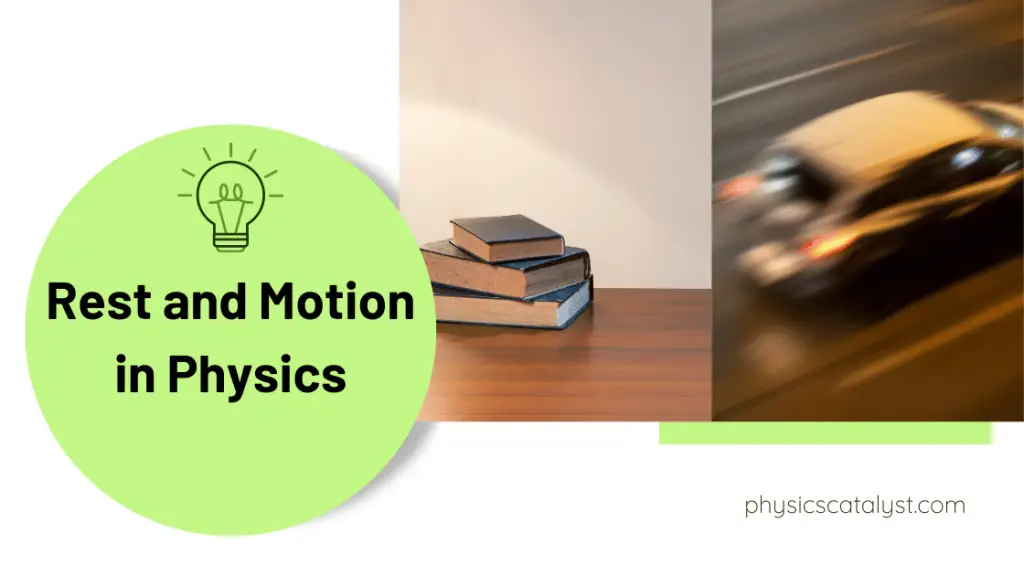The concept of motion and rest are fundamental concepts for studying physics. An object is said to be in motion if its position changes with time. It is considered to be at rest if its position remains unchanged over time.
But, these definitions are not absolute. Both motion and rest are relative terms. This means that whether the object under observation is at rest or in motion depends on the observer’s frame of reference.

A clear understanding of motion and rest is very important for solving kinematics questions. Problems in electricity and magnetism can also be solved using the motion and rest principle. In this article, we will understand the concept of rest and motion in detail.
Table of Content
- Definition of Rest
- Definition of Motion
- Describing Rest and Motion
- Motion and Rest are Relative
- Frames of Reference
- Concept of Reference Point
What is rest and motion in physics?
Definition of rest
So, what is rest in physics?
If the position of the object does not change with the passage of time then the object is said to be at rest.
It is important to note here that rest in physics is defined relative to an observer’s frame of reference.
In physics, the concept of rest is not absolute but relative. This means that an object at rest in one frame of reference may be in motion in another. This relativity of rest is fundamental to understanding many physical phenomena and is a cornerstone of Einstein’s theory of relativity.
Examples of rest
- A book lying on a table is at rest as it is not changing its position with respect to the table.
- A person sitting still in a chair is at rest relative to the room they are in.

Remember, these examples are based on specific frames of reference. For instance, the book is at rest relative to the table, but if you consider the rotation and revolution of the Earth, the book is actually in motion.
Definition of motion
An object is said to be in state of motion if its position changes with the passage of time.
In physics, motion refers to the change in position of an object with respect to its surroundings in a given period of time. Like rest, motion is also relative.
An object is in motion if it changes its position over time, as observed from a particular frame of reference. This concept is fundamental in physics and forms the basis for understanding various phenomena in mechanics, electromagnetism, quantum physics, and more.
Examples of motion
- A car driving down a road is in motion as it is changing its position with respect to the surroundings.
- A child swinging on a swing is in motion as the child’s position is changing with respect to the swing set.

Describing rest and motion
We have now defined what is motion and what is rest in physics. let us learn how we can describe objects in rest and motion.
Describing Motion
For describing motion we will start with the simplest form of motion. One-dimensional motion (Motion In a Straight Line) is the simplest form of motion. One example of such kind of motion is a car moving on the road.
To understand the motion of this car, we need to track the car’s position at different times. We can do this by measuring its distance from a starting point, like the beginning of the road, at regular intervals.
We can record these measurements in a table or, even better, plot them on a graph. This distance versus time graph (Position Time Graph) provides a visual representation of how the car is moving.
Describing Rest
When we say an object is at rest, we mean that its position is not changing over time relative to its surroundings. Let’s consider a simple example: a book lying on a table.
To understand this state of rest, we observe the book over a period of time. If the book’s position on the table does not change, we say the book is at rest relative to the table.
We could record the book’s position at different times, and just like with the car, we could plot these positions on a graph. But, in this case, the graph would be a straight horizontal line, indicating that the book’s position is constant over time.
Motion and Rest are Relative
Beyond our example of the car, we encounter many moving objects in our everyday life that we might want to describe.
It’s important to understand that both rest and motion are relative terms. By this, we mean that there’s no such thing as absolute rest or absolute motion.
Take a moving train for instance. Two individuals seated inside the moving train are at rest relative to each other, but for a person observing from the roadside, they are in motion.
Thus, an object that seems at rest to one observer might appear to be in motion to another. It all boils down to the choice of frame of reference we use to observe a particular object.
Building on our understanding of rest and motion, it’s important to introduce the concept of a frame of reference. This is a necessary tool for describing the state of an object, be it at rest or in motion.
Frames of reference
A frame of reference is essentially a coordinate system, coupled with a clock, fixed to a reference body. To locate an event within this frame, we generally need to know its position and the time of its occurrence. This requires four coordinates: x, y, z for space, and t for time, hence the term ‘space-time frame of reference’.
The simplest frame of reference we often use is the Cartesian coordinate system. However, coordinate systems can also be curvilinear (spherical or cylindrical coordinate systems). The choice of a coordinate system depends on the symmetry and formulation of the problem, aiming to simplify our solution.
Frames of reference can be classified into two types: Inertial and Non-Inertial.
1. Inertial Frame of Reference:
An inertial frame of reference is one where, if no external force is acting on a particle, the particle appears to move at a constant velocity or experiences no acceleration.
In other words, in the absence of external forces, the particle’s velocity remains constant. This means that Newton’s first and second laws of motion are always valid in an inertial frame of reference.
Upon analysis, it’s found that such frames are either at rest or moving with a constant velocity. Therefore, for an observer at rest or moving at a constant velocity, the frame of reference is always an inertial one.
2. Non-Inertial Frame of Reference:
Contrary to the inertial frame, a non-inertial frame of reference is one where Newton’s first and second laws of motion do not hold true. In a non-inertial frame, the observer or the frame of reference itself accelerates, and a particle or object observed relative to them appears to be accelerated even in the absence of any externally applied force.
Concept of reference point
Building on our understanding of frames of reference, let’s now explore the concept of a reference point. A reference point is a specific location within the frame of reference that we use as a starting point for measuring or describing motion.
It’s the ‘zero’ of our coordinate system, the point from which all other positions are determined.
Imagine you’re watching a boat sailing on a lake. You could choose a specific landmark on the shore, like a large rock or a dock, as your reference point. The boat’s position can then be described in terms of its distance and direction from this landmark.
By selecting a suitable reference point, we can simplify our description of the boat’s motion, making it easier to understand and analyze.